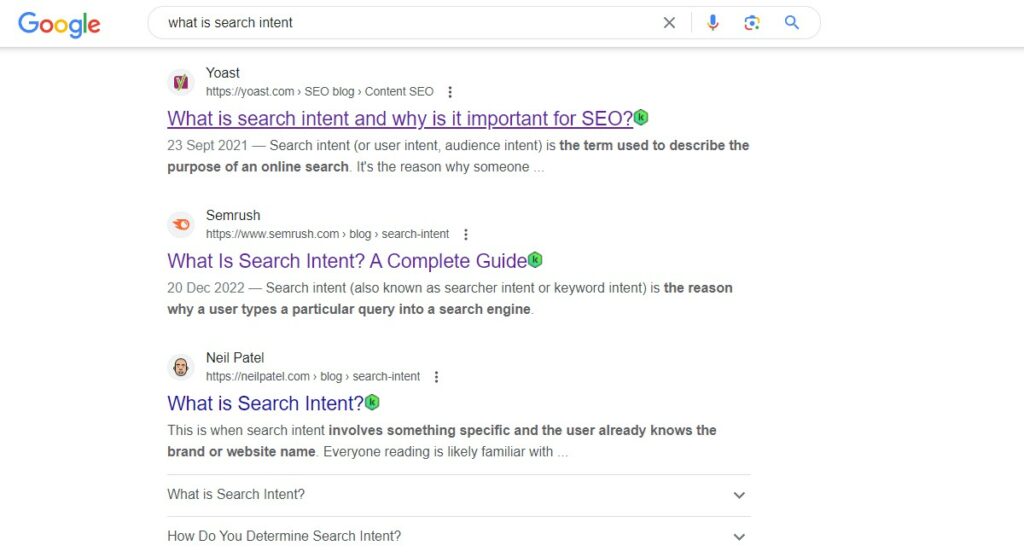*This article was last updated on 12/09/2023
Imagine you’re a ship’s captain, charting a course through the vast, unpredictable ocean. Your destination is in mind, but you’re unsure of the best route. That’s a lot like trying to navigate the world of SEO without understanding search intent.
It’s a crucial part of the journey that many businesses overlook, and it can mean the difference between reaching your destination or getting lost at sea. However, despite its importance, search intent is often overlooked in many businesses’ SEO strategies.
What is Search Intent

Search intent is like reading your customers’ minds. It’s about understanding what they’re really looking for when they type a query into a search engine.
- Are they looking for information?
- Are they trying to make a purchase?
- Or are they simply trying to navigate to a specific website?
Each of these queries has a different intent. Understanding that intent is vital to meeting your customers where they are.
What Happens If You Ignore Search Intent
Navigating the SEO landscape without the compass of search intent can lead to many issues. First and foremost, you need to align your content with the intent of your audience to achieve high rankings in search engine results pages (SERPs).
Google, Bing, and other search engines have algorithms designed to prioritize content that best matches a user’s intent. If your content fails to align with users’ needs, you’ll struggle to gain significant web visibility.
Even if you get some traction, failing to meet search intent could result in getting the wrong kind of visitors. That can result in lower click-through rates, less engagement, and fewer conversions.
There are 4 Types of Search Intent
Before we delve into the solution, it’s crucial to understand the various types of search intent. Each of these intents requires a different approach in terms of content creation and SEO strategy. You must consider them when crafting your content to ensure you fit all the significant pieces of the SEO puzzle.
Informational Search Intent
This type of search intent is all about the quest for knowledge. Users with informational intent have a question or problem they’re looking to solve and turn to the search engine for answers.
The queries could range from simple facts, like “What’s the capital of France,” to more complex questions, like “How does blockchain technology work.”
These users aren’t typically ready to buy anything – they’re in the research phase. To cater to informational intent, your content should be educational and provide clear, concise answers to common questions. Think blog posts, how-to guides, and explainer videos.
Aim for around 40-50% of your content to be informational.
Navigational Search Intent
This intent is straightforward. Users with navigational intent already know where they want to go; they’re just using the search engine as a tool to get there. These searches are usually brand-specific, like “Facebook login” or “OpenAI blog.”
If you’re seeing a lot of navigational queries leading to your site, it’s a good sign that your brand is top-of-mind for consumers. For navigational intent, ensure your website is easily navigable and key pages are indexed to appear in search results.
Navigational intent is typically out of your hands, as these users already know your brand and seek your website.
Transactional Search Intent
These are the users ready to make a purchase. Transactional intent is clear from searches like “buy iPhone 12 Pro Max” or “subscribe to New York Times.” These people have done their research and decided and are now ready to take action.
To cater to transactional intent, ensure your product or service pages are optimized for search, with clear calls to action and a smooth checkout process. This should make up about 20-30% of your content.
Commercial Investigation
These searches fall somewhere between informational and transactional intent. Users with commercial investigation intent are considering a purchase and are comparing their options. They might search for “best DSLR cameras 2023” or “iPhone 13 vs. Samsung Galaxy S21 review.”
They’re looking for content that compares products, prices, features, etc. Create comparison articles, product reviews, and buyer’s guides to address this intent. This is your opportunity to convince users that your product or service is the best choice.
The remaining 20-30% of your content should target users in the commercial intent phase.
How to Determine Search Intent
Now that we understand the problem and the different types of search intent let’s explore the solution. It’s simple: to improve your SEO rankings and connect more effectively with your audience, you need to understand and optimize for search intent.
Perform Keyword Analysis
Look at the keywords users are typing into search engines. Are they primarily informational, navigational, transactional, or commercial investigation queries? This can give you a clue about what your audience is looking for.
Review SERPs
way to determine search intent is by analyzing the SERPs for a specific keyword. Google and other search engines aim to provide the most relevant results for a user’s query. Therefore, the type of content that ranks highly for a keyword can give you insight into the search intent behind that keyword.
For example, the search intent is likely transactional if a query returns many product pages. On the other hand, if the results are mainly blog posts or how-to guides, the intent is probably informational.
Use SEO Tools
There are various SEO tools available that can help you identify search intent. Tools like SEMRush, Ahrefs, and Moz provide keyword analysis features that can give you insights into the potential search intent behind different keywords.
Listen to Your Audience
Finally, always appreciate the value of direct feedback from your audience. Surveys, customer interviews, and social media interactions can provide valuable insights into what your audience is searching for and why.
How to Optimize Content for Search Intent
Understanding and aligning your content with search intent is about more than just improving your SEO rankings. It’s about providing value to your audience and creating a better user experience.
By aligning your content with search intent, using relevant keywords, and continuously monitoring and adjusting, you can create content that truly resonates with your audience and achieves your business goals.
Create Relevant Content
Tailor your content to match the identified intent.
- For informational queries, create educational content.
- For navigational queries, ensure your site is easy to navigate.
- For transactional queries, optimize your product pages.
- And for commercial investigation queries, create comparison articles and product reviews.
Use The Right Keywords
Incorporate the keywords that match your audience’s intent into your content, titles, meta descriptions, and alt tags. This helps search engines understand what your content is about and who it’s relevant for.
Improve Your Site Layout and Structure
Ensure your website is easy to navigate, with a clear structure and intuitive design. This improves user experience and makes it easier for search engines to crawl and index your site.
Monitor and Adjust Your Tactics
SEO is not a set-it-and-forget-it strategy. You should continuously monitor your content’s performance and user behavior data. If a piece of content isn’t performing as well as you’d hoped, it may not align with the search intent of your target audience.
Best Practices to Meet Search Intent
Navigating the waters of search intent can be challenging, but with a few best practices, you can effectively meet your audience’s intent and enhance your SEO efforts. Here are some key strategies to consider:
Analyze Your Competitors
Your competitors can provide valuable insights into search intent. Analyze their content to see what type of search intent they’re targeting. Are they focusing on informational content, transactional content, or a mix of both?
Use Clear and Descriptive Headings
Headings not only help structure your content and make it easier to read, but they also help search engines understand what your content is about. Use your headings to signal the content’s subject and relevance to the user’s search intent.
Optimize Your Meta Descriptions
Meta descriptions give users a preview of your content on SERPs. Ensure your meta descriptions accurately describe your content and match the user’s search intent. Carefully consider what they might want to see on each specific piece of content.
Understand the User Journey
Search intent can change as users move through the buyer’s journey. In the awareness stage, they might have informational intent, but as they move to the decision stage, their intent might become transactional.
Tailor your content to meet the changing intent of your users as they progress through their journey.
Wrapping Up: The Power of Understanding Search Intent
In the words of Peter Drucker, “Marketing aims to know and understand the customer so well the product or service fits him and sells itself.” By understanding intent, you’re fitting your content to your audience and your audience’s journey.
From informational to navigational, transactional, and commercial investigation, each type of intent represents a unique opportunity to connect with your audience and meet their needs.
Remember, It’s not just about getting traffic to your site. It’s about attracting the right kind of traffic. These users are genuinely interested in what you offer and are more likely to convert.

